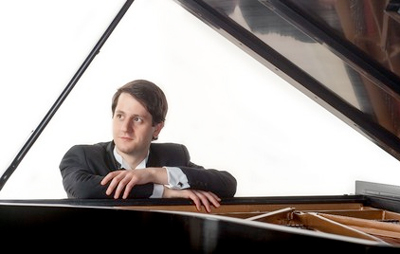by Tom Wachunas

Prokofiev’s Piano Concerto No. 2 with Russian guest soloist Nikita Mndoyants was the centerpiece of the program. This concert was billed as “Passionate Piano,” though “Daunting Piano” might arguably be more apropos. While the concerto is a famously difficult one for the soloist, it can be equally so for some if not many listeners. Amid its florid cadenzas are dizzying passages of trills and torrents of sixteenth notes, relentlessly grinding rhythms, and acerbic dissonances. In this work the orchestra itself was often an audience of sorts. This is not to say that the ensemble members were inactive listeners, but rather that the music they were playing seemed to represent responses at various times ranging from tentative nods of approval to vigorous shouts of both delight and terror at where the piano was leading them.
Likewise, Gerhardt Zimmermann’s conducting demeanor was in no way detached or impersonal. On the contrary, he appeared fully invested in the sheer adrenalin rush of the music. At one point during the mesmerizing piano arpeggios of the third movement, he let fly his baton and it twirled through the air in a quick blur, landing inside the piano with a distinctive clicking noise. It was a curious accident, to be sure, yet oddly appropriate to the music, like a punctuation mark in a run-on sentence.
The concerto is comprised of many such sentences. Some are notably piquant or lyrical in character, such as the Russian folk melody suggested in the final movement. But most are phrases of a more strident, ferocious nature, uttered many times with breakneck speed. Speaking them with clarity requires electrifying virtuosity on the part of the soloist. Mndoyants, winner of the Mixon First Prize at the 2016 Cleveland International Piano Competition, demonstrated as much, and more, with astonishing fluidity. Beyond his unquestionable technical prowess was a riveting command of the music’s explosively dramatic nuances, articulated here with steely determination. The muscular, triumphant cadence of the finale conjured visions of a victorious athlete crossing the finish line after an exhausting run, and immediately lifted many of us in the audience out of our seats and into a hearty outburst of well-earned bravos.
In the end, I gained an appreciation that had always eluded me when listening to recordings of this concerto. Challenging music such as this is best experienced during a live performance. I don’t believe that even the finest recording can make its daring spirit palpable enough. It speaks most powerfully as an event — an adventure unfolding before us in real time.
A wholly different sort of unfolding transpired in the orchestra’s magnificent performance of Symphony No. 5 by Jean Sibelius. If Prokofiev’s concerto could be called devilish, then this Sibelius masterpiece of enthralling lyricism is comparatively divine. “In a deep valley again,” the composer tells us in a 1915 diary entry, “But I already begin dimly to see the mountain that I shall surely ascend…God opens His door for a moment and His orchestra plays the fifth symphony.”
Here was a call for every section of the ensemble to truly shine, and they rose to the occasion with awesome radiance. The horns were haunting, the winds sweet and crisp as they scampered and cavorted, and the strings soared into heights of dramatic sonority as deftly as they seemed to hover in hushed valleys of pizzicato contemplation.
And then there is that glorious finale. Unique in the symphonic repertoire, we hear a breathtaking set of six robust chords, joyous shouts really, separated by silences, as if Heaven has ordered quiet. It was a stunning reminder that silences can be potent notes, indeed adventures, unto themselves.
Published on ClevelandClassical.com March 1, 2017.
Click here for a printable copy of this article



